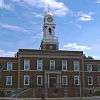Freeport, New York
Freeport (officially The Incorporated Village of Freeport) is a village in the town of Hempstead, Nassau County, New York, US, on the South Shore of Long Island. The population was 43,713 at the 2010 census.[3] A settlement since the 1640s, it was once an oystering community and later a resort popular with the New York City theater community. It is now primarily a bedroom suburb but retains a modest commercial waterfront and some light industry. It is serviced by the Freeport station on the Long Island Rail Road.
Freeport, New York | |
|---|---|
Village | |
| Incorporated Village of Freeport | |
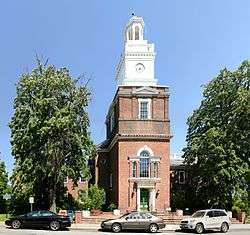 Freeport Village Hall, also known as the Municipal Building, was built in 1928 to replicate Independence Hall in Philadelphia, and was enlarged in 1973. | |
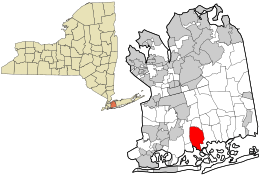 Location in Nassau County and the state of New York. | |
 Freeport, New York Location within the state of New York | |
| Coordinates: 40°39′14″N 73°35′13″W | |
| Country | United States |
| State | New York |
| County | Nassau |
| Incorporated | 1892[1] |
| Government | |
| • Mayor | Robert T. Kennedy |
| Area | |
| • Total | 4.8 sq mi (12.5 km2) |
| • Land | 4.6 sq mi (11.9 km2) |
| • Water | 0.2 sq mi (0.6 km2) |
| Elevation | 20 ft (6 m) |
| Population (2010) | |
| • Total | 42,860 |
| • Estimate (2019)[2] | 42,956 |
| • Density | 8,900/sq mi (3,400/km2) |
| Time zone | UTC-5 (Eastern (EST)) |
| • Summer (DST) | UTC-4 (EDT) |
| ZIP code | 11520 |
| Area code(s) | 516 |
| FIPS code | 36-27485 |
| GNIS feature ID | 2390852 |
| Website | www |
Description
Freeport lies on the South Shore of Long Island,[4] in the southwestern part of Nassau County, within the town of Hempstead. Freeport has its own municipal electric utility, and police, fire, and water departments. Freeport is New York State's second-biggest village[5] and has a station on the Long Island Rail Road.

The south part of the village is penetrated by several canals that allow access to the Atlantic Ocean by means of passage through salt marshes. The oldest canal is the late 19th-century Woodcleft Canal.[4] Freeport has extensive small-boat facilities and a resident fishing fleet, as well as charter and open water fishing boats.
Geography
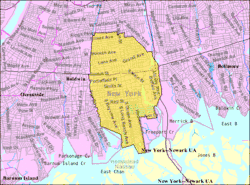
Location
Freeport is located at 40°39′14″N 73°35′13″W (40.653935, −73.587005).[6]
The village is bisected by east-west New York State Route 27 (Sunrise Highway). Meadowbrook Parkway defines its eastern boundary.
Surrounding communities
Baldwin lies to the west, Merrick to the east, and Roosevelt to the north. Freeport is bounded to the south by salt flats and bays.
Government
Freeport's government is made up of four trustees and a mayor, who are elected to four-year terms; one trustee also serves in the capacity of deputy mayor. Freeport's first African American mayor, Andrew Hardwick, was elected in 2009; he was succeeded on March 20, 2013 by Robert T. Kennedy[5] The current Deputy Mayor is (Trustee) Jorge Martinez. The other current Trustees are, Carmen Piñeyro, Ronald Ellerbe, and Christopher Squeri. Freeport's current government is a bipartisan coalition of Democrats and Republicans.
Demographics
| Historical population | |||
|---|---|---|---|
| Census | Pop. | %± | |
| 1880 | 1,217 | — | |
| 1900 | 2,612 | — | |
| 1910 | 4,836 | 85.1% | |
| 1920 | 8,599 | 77.8% | |
| 1930 | 15,467 | 79.9% | |
| 1940 | 20,410 | 32.0% | |
| 1950 | 24,680 | 20.9% | |
| 1960 | 34,419 | 39.5% | |
| 1970 | 40,374 | 17.3% | |
| 1980 | 38,272 | −5.2% | |
| 1990 | 39,894 | 4.2% | |
| 2000 | 43,783 | 9.7% | |
| 2010 | 42,860 | −2.1% | |
| Est. 2019 | 42,956 | [2] | 0.2% |
| U.S. Decennial Census[7] | |||
As of the census[8] of 2000, there were 43,783 people, 13,504 households, and 9,911 families residing in the village. The population density was 9,531.3 people per square mile (3,682.9/km²). There were 13,819 housing units at an average density of 3,008.3 per square mile (1,162.4/km²). The racial makeup of the village was 42.9% White, 32.6% African American, 0.5% Native American, 1.4% Asian, 0.1% Pacific Islander, 17.2% from other races, and 5.4% from two or more races. Hispanic or Latino of any race were 33.5% of the population.[9]
There were 13,504 households out of which 36.4% had children under the age of 18 living with them, 49.7% were married couples living together, 17.8% had a female householder with no husband present, and 26.6% were non-families. 21.2% of all households were made up of individuals and 8.1% had someone living alone who was 65 years of age or older. The average household size was 3.20 and the average family size was 3.65.
In the village, the population was spread out with 26.4% under the age of 18, 9.1% from 18 to 24, 32.1% from 25 to 44, 22.0% from 45 to 64, and 10.5% who were 65 years of age or older. The median age was 35 years. For every 100 females, there were 92.6 males. For every 100 females age 18 and over, there were 89.3 males.
The median income for a household in the village in 1999 was $55,948, and the median income for a family was $61,673. Males had a median income of $37,465 versus $31,869 for females. The per capita income for the village was $21,288. About 8.0% of families and 10.6% of the population were below the poverty line, including 11.5% of those under age 18 and 7.4% of those age 65 or over.
As of 2010, the population was 42,860. The demographics were as follows:[10]
- Hispanic – 17,858 (42.5%)
- Black alone – 13,226 (30.9%)
- White alone – 10,113 (23.6%)
- Asian alone – 669 (1.6%)
- Two or more races – 174 (0.4%)
- Other race alone – 292 (0.7%)
- American Indian alone – 94 (0.2%)
Transportation
Freeport is served by the Freeport station on the Long Island Rail Road Babylon Branch. It is also a hub for several Nassau Inter-County Express bus routes.
- N4: Freeport – Jamaica
- N19: Freeport – Sunrise Mall
- N40: Freeport – Mineola via North Main Street
- N41: Freeport – Mineola via Babylon Turnpike
- N43: Freeport – Roosevelt Field Mall
- N88: Freeport – Jones Beach (Summer Service Only)
History
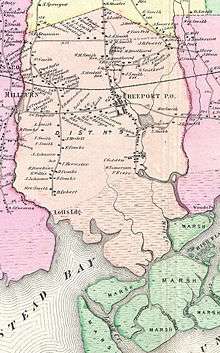
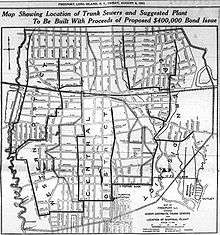
Pre-colonial settlement
Before people of European ancestry came to the area, the land was part of the territory of the Meroke Indians.<uref name=Bleyer>Bill Bleyer, Freeport: Action on the Nautical Mile, Newsday.com. Retrieved November 14, 2008. Archival copy at the Wayback Machine (archived June 20, 2009).</ref>[11] Written records of the community go back to the 1640s.[11] The village now known as Freeport was part of an area called "the Great South Woods" during colonial times.[11] In the mid-17th century, the area was renamed Raynor South, and ultimately Raynortown, after a herdsman named Edward Raynor, who had moved to the area from Hempstead in 1659, cleared land, and built a cabin.[4][11][12]
19th century: development
In 1853, residents voted to rename the village Freeport, adopting a variant of a nickname used by ship captains during colonial times because they were not charged customs duties to land their cargo.[4][11][12]
After the Civil War, Freeport became a center for commercial oystering. This trade began to decline as early as the beginning of the 20th century because of changing salinity and increased pollution in Great South Bay.[13] Nonetheless, even as of the early 21st century Freeport and nearby Point Lookout have the largest concentration of commercial fishing activity anywhere near New York City.[14]
From 1868, Freeport was served by the Southside Railroad, which was a major boon to development. The most prominent figure in this boom was developer John J. Randall; among his other contributions to the shape of Freeport today were several canals, including the Woodcleft Canal, one side of which is now the site of the "Nautical Mile".[13] Randall, who opposed all of Freeport's being laid out in a grid, put up a Victorian house virtually overnight on a triangular plot at the corner of Lena Avenue and Wilson Place to spite the grid designers.[15] The Freeport Spite House still is standing and occupied.[15]
In January 1873, before Nassau County had split off from Queens, the Queens County treasurer set up an office at Freeport.[16] The village residents voted to incorporate the village on October 18, 1892.[4][11] At that time, it had a population of 1,821.[12] In 1898, Freeport established a municipal electric utility, which still operates today, giving the village lower electricity rates than those in surrounding communities.[13] It is one of two municipally owned electric systems in Nassau County; the other is in Rockville Centre.[17] Public street lighting was begun in 1907, and a public fire alarm system was adopted in 1910.[18]
1900–1939: expansion
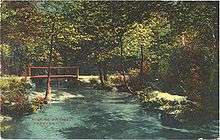
In the years after incorporation, Freeport was a tourist and sportsman's destination for its boating and fishing.
From 1902 into the late 1920s, the New York and Long Island Traction Corporation ran trolleys through Freeport to Jamaica, Hempstead, and Brooklyn. These trolleys went down Main Street in Freeport, connecting to a ferry near Woodcleft Avenue. The ferries took people to Point Lookout, about three miles (5 km) south of Freeport, where there is an ocean beach. For a few years after 1913, the short-lived Freeport Railroad ran a train nicknamed "the Fishermen's Delight" along Grove Street (now Guy Lombardo Avenue) from Sunrise Highway to the waterfront.[13] Also in this era, in 1910 Arthur and Albert Heinrich flew the first American-made, American-powered monoplane, built in their Merrick Road airplane factory (see also Heinrich Pursuit).[13] WGBB, founded in 1924, became Long Island's first 24-hour radio station.[13]

In the late 19th century, Freeport was the summer resort of wealthy politicians, publishers, and so forth. At the time, travel from Freeport to New York City required a journey of several hours on a coal-powered train, or an even more arduous automobile trip on the single-lane Merrick Road.
According to Elinor Smith, the arrival of Diamond Jim Brady and Lillian Russell around the start of the 20th century marked the beginning of what by 1914 would become an unofficial theatrical artists' colony, especially of vaudeville performers.[19] Freeport's population was largest in the summer season, during which most of the theaters of the time were closed and performers left for cooler climes.[13] Some had year-round family homes in Freeport.[20] Leo Carrillo and Victor Moore were early arrivals,[21] later joined by Fannie Brice, Trixie Friganza, Sophie Tucker, Harry Ruby,[22] Fred Stone, Helen Broderick, Moran and Mack, Will Rogers, Bert Kalmar, Richard Whiting, Harry von Tilzer, Rae Samuels, Belle Baker, Grace Hayes, Pat Rooney, Duffy and Sweeney, the Four Mortons, McKay and Ardine, and Eva Tanguay. Buster Keaton, W. C. Fields, and many other theatrical performers who did not own homes there were also frequent visitors.[21]
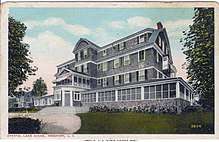
Several of Freeport's actors gathered together as the Long Island Good Hearted Thespian Society (LIGHTS), with a clubhouse facing onto Great South Bay.[13][23] LIGHTS presented summer shows in Freeport from the mid-1910s to the mid-1920s.[13] LIGHTS also sponsored a summertime "Christmas Parade", featuring clowns, acrobats, and once even some borrowed elephants. It was held at this unlikely time of year because the theater people were all working during the real Christmas season.[24] A Coney Island–style amusement park called Playland Park thrived from the early 1920s until the early 1930s but was destroyed by a fire on June 28, 1931.[25][26]
With the resurgence of the Ku Klux Klan on Long Island in the 1920s many villages in Nassau and Suffolk counties were the focal point of Klan activity. According to a story in Newsday detailing the history of Long Island,
often, respected clergymen and public officials openly supported the Klan and attended its rallies. On Sept. 20, 1924, for instance, the Klan drew 30,000 spectators to a parade through Freeport – with the village police chief, John M. Hartman, leading a procession of 2,000 robed men.... the founding of one of Long Island's first klaverns, in Freeport, was memorialized on Sept. 8, 1922, in the Daily Review, which carried a banner headline about the meeting at Mechanics Hall on Railroad Avenue. About 150 new members were greeted by seven robed Klansmen.[27]
1940–present: recent history
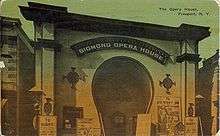
By 1937, Freeport's population exceeded 20,000, and it was the largest village in Nassau County.[12] After World War II the village became a bedroom community for New York City. The separation between the two eras was marked by a fire that destroyed the Shorecrest Hotel (originally the Crystal Lake Hotel) on January 14, 1958.[26] During the 1950s local merchants resisted building any shopping malls in the village and subsequently suffered a great loss of business when large malls were built in communities in the central part of Long Island.
The landscape of Freeport underwent further change with a significant increase in apartment building construction. When such buildings went up in just two years in the early 1960s, the Village passed a moratorium on multi-unit residential construction.[28]
While never a major boatbuilding center, Freeport can boast some notable figures in that field. Fred and Mirto Scopinich operated their boatyard in Freeport from just after World War I until they moved it to East Quogue in the late 1960s. Their Freeport Point Shipyard built boats for the United States Coast Guard, but also for Prohibition-era rumrunners.[29] From 1937 to 1945 the shipyard built small boats for the United States Navy and British Royal Navy.[13] The marina and dealership operated by Al Grover in 1950 remains in Freeport and in his family. Grover's company built fishing skiffs from the 1970s until about 1990. One of these, a 26-footer, carried Grover and his sons from Nova Scotia to Portugal in 1985, the first-ever crossing of the Atlantic Ocean by a boat powered by an outboard motor.[13] Columbian Bronze operated in Freeport from its 1901 founding until it closed shop in 1988. Among this company's achievements was the propeller for the USS Nautilus, an operational nuclear-powered submarine and the first vessel to complete a submerged transit across the North Pole.[13]
Culture
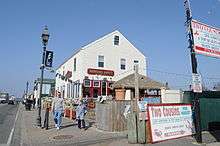
Freeport is a Long Island hot spot during the summer season in New York. A popular festival occurs on Freeport's Nautical Mile (the west side of Woodcleft Canal) the first weekend in June each year, which attracts many people from across Long Island and New York City. The Nautical Mile is a strip along the water that features well-known seafood restaurants, crab shacks, bars, eclectic little boutiques, fresh fish markets, as well as party cruise ships and casino boats that float atop the canals. People line up for the boat rides and eat at restaurants that feature seating on the water's edge and servings of mussels, oysters, crabs, and steamed clams ("steamers") accompanied by pitchers of beer. An 18-hole miniature golf course is popular among families. The Sea Breeze waterfront park—which includes a transient marina, boardwalk, rest rooms and benches—opened in 2009 at the foot of the Nautical Mile. It has proven to be a very popular spot to sit and watch the marine traffic and natural scenery. This is in addition to an existing scenic pier.
Freeport has an ethnically and racially diverse population. There is one housing project, named after Nassau County's first black judge, Moxie Rigby. Freeport's Hispanic community is made up of Puerto Ricans and immigrants who hail from Colombia, the Dominican Republic, El Salvador, Guatemala, Honduras, and many other Latin American nations. Among the many Latin-American-themed businesses are the Compare Foods Supermarkets, several grocery stores, and restaurants along Merrick Road and Main Street that serve Caribbean, Central American, Dominican, and South American cuisines.
Freeport, along with neighboring Merrick, is also the gateway to Jones Beach, one of the largest state beaches in New York. One famous area is the Town of Hempstead Marina, where people from all over Long Island dock their boats. Freeport is a 45-minute ride by the Long Island Rail Road to Manhattan, making the trip an easy commute to New York City.
From 1974 to 1986, Freeport was one of the few Long Island towns to hold a sizeable open-air market area, known as the Freeport Mall.[30] The heart of the Main Street business area was closed to vehicular traffic and reconfigured for pedestrians only. The experiment was not a success. The W. T. Grant store that was supposed to anchor the mall closed, along with the rest of that chain, shortly after the mall opened. The mall area became shabby and disused, and many businesses failed. The mall was dismantled and returned to through traffic with regular parking on each side of the street.[31]
Architecture

Just north of the high school and the railroad tracks is the ruin of the former Brooklyn Waterworks, described by Christopher Gray of the New York Times as looking like an "ancient, war-damaged abbey." Designed by architect Frank Freeman and opened in 1891 to serve the City of Brooklyn (later made a borough of New York City), it was fully active until 1929 with a capacity of 54 million gallons a day, and remained in standby for emergency use until 1977, when the pumps and other machinery were removed. See Ridgewood Reservoir. An unsuccessful 1989 plan would have turned the building into condos.[32][33] Currently, the parcel is the subject of litigation and ongoing investigations by various agencies. Long Island Traditions also describes the sites of notable architecture in Freeport's history, such as bay men's homes[34] and commercial fishing establishments,[35] some of which are still existing, as well as the still-existing Fiore’s Fish Market and Two Cousins, which are located in historic waterfront buildings, built by the owners, so they could negotiate directly with the baymen as they pulled into dock.[36]
Long Island Traditions also describes and provides a photograph of the no-longer existing Woodcleft Hotel[37] and important boatyards, about which the site writes:[38]
In Freeport the Maresca boatyard stands on the site of what is now the Long Island Marine Education Center owned by the Village of Freeport. Founded in the 1920s by Phillip Maresca, they built both recreational and commercial boats. Their customers included Guy Lombardo and party boat captains. The business was taken over by Everett Maresca, who died in 1995. The original building remains relatively intact, consisting of a large concrete block structure. Further down on Woodcleft Canal stands the former Scopinich Boatyard, now part of Shelter Point Marine services. The structure is obscured by corrugated metal siding but elements of its original frame structure remain. The yard was founded by Fred Scopinich, a Greek immigrant in the early 1900s. His grandson Fred moved the yard to East Quogue. The Freeport yard specialized in building commercial fishing boats including trawlers, government boats for the Coast Guard, rum running boats, as well as sailboats and garveys for local baymen. Finally the original Grover boatyard, founded by Al Grover, stands on Woodcleft Avenue a short distance from the Maresca yard. A modest frame building, approximately 20 people worked there. Today the yard is located north of the Nautical Mile on South Main street, run by Grover’s sons. Their yard consists of modern corrugated structures used primarily for maintenance and storage.
Freeport Memorial Library
The Freeport Memorial Library is one of Nassau County's largest public libraries. The library was founded in 1884 as part of the school system, granted a provisional charter by the state Board of Regents in 1895, and a permanent charter on December 21, 1899. In 1911 it was moved from a school building to a rented room in the Miller Building on South Grove Street. At that time it was a membership library: members paid ten cents for a card and were permitted to borrow two books at a time, one fiction and one nonfiction.[39]
A drive was started in 1920 to construct a library building. The resulting library at the corner of Merrick Road and Ocean Avenue, a Beaux Arts building designed by architect Charles M. Hart, opened on Memorial Day, 1924. A year later it was renamed Freeport Memorial Library. In 1928, a tablet was erected with the names of Freeport's war dead from the American Civil War, Spanish–American War, and World War I.[39]
Additional wings were dedicated on April 19, 1959, and on Memorial Day, 1985. Plaques were added to honor Freeporters who died in World War II, the Korean War, and the Vietnam War.[39]
Schools
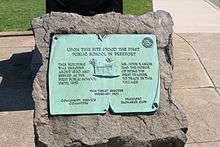
Freeport Public Schools (FPS) operates the community's public schools.
For the 2009–10 school year, there were 6,257 students enrolled in Freeport's public schools.[40] The children of Freeport, in grades 1–4, attend four magnet elementary schools, each with a different specialty: Archer Street (Microsociety and Multimedia), Leo F. Giblyn (School of International Cultures), Bayview Avenue (School of Arts and Sciences), and New Visions (School of Exploration & Discovery). In grades 5 and 6, all public school children attend Caroline G. Atkinson School on the north side of the town. Seventh and 8th graders attend John W. Dodd Middle School. The Middle School is built on the property that housed the older Freeport High School, but not on exactly the same site. The old high school served for some years as the junior high; then the new junior high was built on what was previously parking lot and playground, and the old building was torn down. In 2017, The school remodeled, with an added track and field. A Catholic school, the De La Salle School, is run by the Christian Brothers and accepts boys from grades 5–8.
Children in grades 9–12 attend Freeport High School, which borders the town of Baldwin and sits beside the Milburn duck pond, which is fed by a creek, several hundred yards of which was diverted underground when the high school was built. Freeport High School's mascot is the Red Devil, and its colors are red and white. The school has track-and-field facilities. One unique feature of the school's curriculum is a science research program run in cooperation with Stony Brook University. The school offers numerous advanced placement courses and was a pioneer in distance learning at the high school level. Roughly 87 percent of the high school's graduates go on to some form of higher education. A community night school for teenagers had 236 students as of 1999.[25]
As early as 1886, Freeport's schools began the then-unusual policy of providing their students with free textbooks. In 1893, the newly incorporated village constructed a ten-room brick schoolhouse. Also in the late 19th century, the community was among the first Long Island communities to establish an "academic department", offering classes beyond the elementary school level.[41]
Freeport saw its share of the social, political, and racial turbulence of the late 1960s and early 1970s. The 1969–70 school year saw three high school principals in the village's only high school, succeeded in August 1970 by William McElroy, formerly the junior high school principal, who came to the position "in the midst of racial tension and a constantly-polarizing student body";[42] McElroy backed such initiatives as a student advisory committee to the Board of Education and, in his own words, "made [him]self available to any civic-minded group" that wished to discuss with him the situation in the school. By May 1972, he could claim success, of a sort. "Formerly, a fight between a black and a white student would automatically become racial; now a fight is just a fight—between two students."[42]
The Freeport High School newspaper, Flashings, founded 1920, is believed to be the oldest high school paper on Long Island.[43] It has won numerous awards over several decades.[44] From 1969 until 1999, it operated under "free press" guidelines unusual for a high school newspaper, with an active role for the students in picking their own faculty adviser and with ultimate editorial control firmly in the hands of students.[43][44] Throughout that time, Ira Schildkraut functioned as faculty adviser.[43][44] In 1999, the school administration removed Schildkraut from that role and attempted to establish themselves as censors.[43][44] That last decision was turned back by the school board after it drew attention from, among others, The New York Times and the Student Press Law Center. However, the dispute's resolution did reduce the student journalists' role in selecting their own faculty adviser and increased the faculty adviser's editorial authority relative to the student journalists'.[44]
From about 1970 to 1973, the town and Freeport High School achieved recognition because of the performance of its math team ("The Mathletes") in regional inter-school math competitions and performance on advanced mathematics tests, including the International Mathematical Olympiad and those from the Mathematical Association of America (MAA).
In addition, in about 1970, Freeport High School became one of the few schools in the country then to have a general purpose computer on the premises dedicated to student use and teaching programming, an IBM 1620 donated by IBM. The 1620 was later replaced by remote access to a DEC System 10 then, later, an on-site PDP-11/40 running the RSTS/E time sharing system, also dedicated to the students. Much credit for the team and computers goes to FHS math teachers and to the Freeport School District's head of Mathematics, Joseph Holbrook.
In June 2008, 16 people were arrested after violence erupted in the high school.[45]
In a 2010 Newsday story regarding Long Island eighth-grader scores on Regents Exams, which have traditionally been given to students in ninth grade and up, Freeport was ranked in the highest tier.[46]
Sports and recreation
In the early 1930s, Freeport was the playing field for the Pennsylvania Red Caps of New York, a semi-pro baseball team which took their name from the caps worn by Pullman porters. For a few years after that, the NFL's Brooklyn Dodgers football team, which, like their Los Angeles Dodgers baseball namesakes, played at Ebbets Field, using the stadium as a midweek training site.[13] The site is now a Warehouse BJ's Wholesale Club.
From 1931 until the early 1980s, Freeport was home to Freeport Speedway,[47] originally Freeport Municipal Stadium. Seating about 10,000, the stadium originally hosted "midget" auto races; after World War II it switched to stock car racing and eventually demolition derbies.[48]
Freeport is home to the Freeport Recreation Center, which features an enclosed, year-round ice skating rink; an indoor pool; an outdoor Olympic-size pool; an outdoor diving tank; an outdoor children's pool; handball courts; sauna; steam room; fully equipped workout gyms; basketball courts; and snack bars serving hot and cold foods. The "Rec Center" also offers evening adult classes and hosts a pre-school program, camp programs, and a senior center.
Notable people
- Cindy Adams, gossip columnist.[13]
- Medea Benjamin (born Susan Benjamin), political activist, co-founder of Code Pink[49]
- Leo Carrillo, actor (Pancho in the Cisco Kid series) built a home on Randalls Channel at the corner of Roosevelt and South Long Beach Avenues.[50]
- Broderick Crawford, actor[13]
- Justin Dunn, baseball pitcher drafted in the 2016 Major League Baseball draft
- Patrick Day, former professional boxer
- Chris Edmonds, 1985 NCAA Division 1 Wrestling Champion[51]
- D'Brickashaw Ferguson, probowl offensive tackle for the New York Jets[52]
- Dick Finley, member of the National Lacrosse Hall of Fame[53]
- Chris Fiore, Major League Lacrosse player
- Flavor Flav (William Jonathan Drayton, Jr.), rapper and reality TV star; grew up in Freeport and neighboring Roosevelt[54]
- Kay Gardner, a musician, composer, author, and musical producer who lived in Freeport[55]
- George Gollin, an elementary particle physicist and physics professor[56]
- Eddie Gordon, professional mixed martial arts fighter and UFC's TUF winner[57]
- Morlon Greenwood, football player[58]
- Andre Harrison, "The Bull", an American mixed martial artist who competes in the Featherweight division of the Professional Fighters League and is their current PFL Featherweight Champion
- Havoc, of hip-hop group Mobb Deep, lives in Freeport[59]
- Gabriel Heatter, radio personality[60]
- Jay Hieron, retired professional mixed martial arts fighter and IFL welterweight champion[61][62]
- Mitch Kapor, founder of Lotus Development Corporation and the designer of Lotus 1-2-3[63]
- Nicholas J. LaBorne, award winning TV producer, director, and broadcast engineer
- Erik Larson, author of books such as Isaac's Storm and The Devil in the White City, attended Freeport High School[64]
- Peter Lerangis, American author of children's and young-adult fiction; valedictorian of the FHS Class of 1973[65]
- Paul Alan Levy, free speech litigator with Public Citizen Litigation Group[66]
- Steve Lieberman, punk rock bassist, flautist, singer signed to JDub Records known as The Gangsta Rabbi; served as Freeport Village Comptroller (1998-2014)[67]
- Guy Lombardo, musician and big bandleader, lived in Freeport during the latter portion of his life; his former residence on South Grove Street (now Guy Lombardo Avenue) included a boathouse where he kept his powerful speed boats, which he raced on the ocean[13]
- Jerry Mackey, a former American football linebacker signed by the Tampa Bay Buccaneers
- Charles Manning, international fashion model[68]
- Donnie McClurkin, Grammy Award-winning American gospel singer, and founder and pastor of Perfecting Faith Church in Freeport[69]
- Christopher Mills, Founder & CEO of Jones Beach Brewing Co.
- Randolph Pope Mills II, known as the Johnny Appleseed of Lacrosse, founded lacrosse programs at Pfeiffer University, Limestone University, Neumann College, and Cabrini College, and started club teams and recreation programs at Gardner-Webb University and UCLA, among many others
- Randolph Pope Mills IV, redefined QB for Nassau, shattered the 33-year-old single-season record for touchdown passes with 30
- Eddie Murphy, attended junior high school at John W. Dodd Middle School
- Billy Murray (singer), Vaudeville-era singer[70]
- Wade Nichols (born Dennis Posa), pornographic actor, cast member in The Edge of Night, and a singer [71]
- Shelly Peiken is an American songwriter who is best known for co-writing the US #1 hits "What A Girl Wants" and "Come On over Baby" by Christina Aguilera.
- Prodigy, of hip-hop group Mobb Deep, lived in Freeport[59]
- Emanuel Pupulidy (1918—1996), a race car driver[72]
- Lou Reed, singer-songwriter and founding member of The Velvet Underground[73]
- Guy Riccardi, a football player and 1963 Thorp Award receipient[74]
- Branch Rickey, owner of the Brooklyn Dodgers[13]
- Dick Schaap, an American sportswriter, broadcaster, and author[75]
- Samantha Sepulveda, a Long Island police officer who gained fame when the New York Post reported that she is also an Internet glamour model
- Henry Slocum, inventor of the inflatable "Mae West" vest-style lifejacket[13]
- Clifton Smith, a former American football linebacker who played college football at Syracuse University
- Elinor Smith, a 1920s aviator[13][76]
- Hale Smith, a 20th-century composer[77]
- Susan Sullivan, an actress[13]
- Brandon Tartikoff, a television executive who grew up in Freeport[13]
- Noel Thompson, National Wrestling Hall of Fame inductee [78] [79]
- Harold E. Varmus, the 1989 recipient of the Nobel Prize in Physiology or Medicine[80][81]
- Chris Weaver, NBC's The Voice (2017)
- Paul Wehrum, member of the National Lacrosse Hall of Fame[82]
- Jean R. Yawkey, wife of Boston Red Sox owner Tom Yawkey and owner of the team from his death in 1976 until her own in 1992; grew up in Freeport.[83]
- Michael Zielenziger, American journalist and author[44]
In popular culture
- History Alive, season 1, episode 56: "Rumrunners, Moonshiners and Bootleggers" (1995) describes boat making operations and illicit business ventures in Freeport.[84]
- The Sopranos, season 5, episode 8: "Marco Polo" (April 25, 2004) reveals that the crew of Lupertazzi crime family member Jerry Basile operates in Freeport.
References
- http://www.queensalive.org/queensalive_history.php
- "Population and Housing Unit Estimates". Retrieved May 21, 2020.<
- "Race, Hispanic or Latino, Age, and Housing Occupancy: 2010 Census Redistricting Data (Public Law 94-171) Summary File (QT-PL), Freeport village, New York". United States Census Bureau. Retrieved October 3, 2011.
- Newsday.com Long Island History: Freeport, Retrieved July 20, 2006.
- Rivera, Laura (April 6, 2009). "300 watch as Andrew Hardwick sworn in as Freeport mayor". Newsday. Retrieved October 4, 2011.
- "US Gazetteer files: 2010, 2000, and 1990". United States Census Bureau. February 12, 2011. Retrieved April 23, 2011.
- "Census of Population and Housing". Census.gov. Retrieved June 4, 2015.
- "U.S. Census website". United States Census Bureau. Retrieved 2008-01-31.
- "Freeport (village) Fact Sheet". U.S. Census Bureau (American FactFinder). Archived from the original on June 20, 2009. Retrieved March 26, 2009.
- "2010 Census data for City of Freeport, NY". zip-codes.com. Retrieved April 4, 2018.
- "L.I. Town Marks Anniversary With Remembrances of Times Gone By; Fete in Freeport to Hail 70th Year: Town to Mark Anniversary With Parade Saturday", The New York Times, October 16, 1962, p. 41.
- "Old Freeport Days: New Development Site Was Once an Indian Encampment", The New York Times, May 23, 1937, p. 199.
- Bill Bleyer, Freeport: Action on the Nautical Mile, Newsday.com. Retrieved November 14, 2008. Archival copy at the Wayback Machine (archived June 20, 2009).
- Point Lookout, Coastal Resources Online, New York State Department of State Division of Coastal Resources. Part of a technical report on Maritime centers. Retrieved November 16, 2008.
- Mason-Draffen, Carrie. (March 30, 1997) Newsday "Living In – Diversity Freely Spices Freeport." Section: Life; Page E25.
- "Long Island". The New York Times. January 13, 1873.
- Smits 1974, p. 51
- Smits 1974, p. 56
- Smith 1981, pp. 22–25
- Smith 1981, pp. 25–34
- Smith 1981, p. 26
- Lawrence van Gelder, "A Pioneer Pilot Clears Some Clouds", The New York Times, July 5, 1981. p. LI2.
- Smith 1981, pp. 27–28
- Smith 1981, p. 28
- John Rather, If You're Thinking of Living In Freeport, The New York Times, January 17, 1999. Retrieved November 16, 2008.
- Miguel Bermudez and Donald Giordano, Freeport Fire Department :: History, Freeport Fire Department. Accessed online 2015-11-17.
- David Behrens, "The KKK Flares Up on LI", Newsday, 1998. Reproduced online at brookhavensouthhaven.org (no archive date) and (archive link) at the Wayback Machine (archived June 12, 2004) from the Newsday "Long Island, Our Story" site. Retrieved October 4, 2011.
- Smits 1974, p. 204
- History Alive: Rumrunners, Moonshiners and Bootleggers Trivia and Quotes (television). History Channel. February 23, 2007. Archived from the original on June 29, 2011. Retrieved March 11, 2011.
- "Board of Trustees Minutes, 1974.
- Special to the New York Times (The New York Times); Metropolitan Desk (December 7, 1986). "Freeport Abandoning Failed Pedestrian Mall". The New York Times. Late City Final Edition, Section 1: Page 54, Column 1, 756 words.
- Christopher Gray, STREETSCAPES: Millburn Pumping Station; A Rundown 'Abbey' Gets New Life as Condominiums, New York Times, October 1, 1989. Retrieved July 20, 2006.
- Brooklyn Water Works on the Long Island Oddities site. Retrieved July 20, 2006.
- "Architecture: Bay Men's Homes". Long Island Traditions. Retrieved November 23, 2012.
- "Commercial Fishing". Long Island Traditions. Retrieved November 23, 2012.
- "Fish Markets & Eateries". Long Island Traditions. Retrieved November 23, 2012.
- "Architecture: South Shore Estuary Site". Long Island Traditions. Retrieved November 23, 2012.
- "Architecture: Boatyards". Long Island Traditions. Retrieved November 23, 2012.
- Freeport Memorial Library History, Freeport Memorial Library official site. Retrieved November 15, 2008.
- NYSED, The New York State District Report Card Accountability and Overview Report 2009–10 Archived March 23, 2012, at the Wayback Machine, New York State Education Department, February 5, 2011. Retrieved April 21, 2011.
- Smits 1974, pp. 31, 33
- Seabrook, Veronica (May 15, 1972). "McElroy Sees Change Evolving". Flashings (Freeport High School newspaper). pp. 3–4.
- Wilgoren, Jodi (November 17, 1999). "Lessons: High School Students Learn About Freedom of the Press". The New York Times. Retrieved November 15, 2008.
- "High School Censorship (Students fight for free press: Editors to retain control over newspaper despite school officials' efforts)". Student Press Law Center Report. XXI (1): 18. Winter 1999–2000. Archived from the original on June 21, 2009. Retrieved November 13, 2008.
- Rivera, Laura (June 17, 2008). "16 Arrested in Freeport High School Melee". Newsday.
- Hildebrand, John (June 22, 2010). "Number of LI eighth-graders taking Regent exams jumps". Newsday. Retrieved October 4, 2011.
- "The History of Freeport Stadium". StockCarRacing.com. Archived from the original on December 5, 2010. Retrieved March 18, 2010.
- "Freeport Speedway: Photos from the 1970s". LaSheef's Racing Photos.
- Freeport High School (1970). Voyageur '70. p. 116. Yearbook.
- Glacken, Bill (November 2004). "Message from the Mayor". freeportny.com. Retrieved November 14, 2008.
- "Chris Edmonds". Lighthousewrestling.com. February 23, 2009. Retrieved January 14, 2015.
- Schlabach, Mark (April 25, 2006). "Ferguson's Weight-and-See Attitude". Washington Post. p. E01. Retrieved November 13, 2008.
- "Richard C. Finley, National Lacrosse Hall of Fame". uslacrosse.org. US Lacrosse, Inc. 1995. Archived from the original on August 6, 2011. Retrieved October 4, 2011.
- Gamboa, Glenn (April 16, 2008). "Flavor Flav's breakout role". Newsday. Retrieved May 12, 2008.
- "Program Notes". USD Symphony. Spring 2002. Archived from the original on May 9, 2008. Retrieved November 14, 2008.
- "Faculty bio for Professor George Gollin, Department of Physics". illinois.edu. University of Illinois. Retrieved March 8, 2008.
- "Eddie Gordon". Sherdog.com.
- "FHS Gridiron Alumnus Funds Weight Room". Freeport Public Schools. Archived from the original on December 1, 2008. Retrieved November 13, 2008.
- Ahmed, Insanul (May 12, 2011). "Prodigy Breaks Down His 25 Most Essential Songs". Complex. Retrieved August 20, 2011.
- "92 Lena Avenue is Landmarked" (PDF). Freeport History Museum. Freeport Historical Society & Museum Newsletter. Spring 2014. p. 2. Retrieved November 18, 2015.
Heatter lived in four homes in Freeport including: 92 Lena Avenue, 470 Pennsylvania Avenue, and 257 Mt. Joy Avenue. We have not identified the fourth house.
- "Jay Hieron". Official website of the International Fight League. Archived from the original on October 15, 2008. Retrieved November 14, 2008.
- "Exclusive interview with Jay Hieron". MMARising.com. Retrieved November 14, 2008.
- "Mitch Kapor". KurzweilAI.net. Archived from the original on June 23, 2009. Retrieved November 13, 2008.
- "Erik Larson, 2003 National Book Award Finalist: Nonfiction". The National Book Foundation. 2003. Retrieved November 13, 2008.
- "Peter Lerangis (contributor bio)". Scholastic.com. Archived from the original on August 19, 2010. Retrieved November 13, 2008.
- "Paul Levy: The Web Bully's Worst Enemy". Washingtonian.com. Retrieved October 21, 2015.
- Epstein, Reid J. (May 3, 2011). "Music is His Message". Newsday. p. A17.
- Freeport Public Schools (June 29, 2014). "Male Models". Huffington Post. Retrieved November 8, 2014.
- "Profile: Donnie McClurkin". PBS Religion & Ethics. May 6, 2005. Retrieved November 14, 2008. (Episode no. 836)
- "W. 'Billy' T. Murray Singing Nightingale, Buried in Holy Rood". denvernightingale.com. Retrieved July 8, 2016.
- "Richmond_Times_Dispatch_1982-07-24_6 (4950x3831 pixels)". archive.is. December 21, 2018. Archived from the original on December 21, 2018. Retrieved April 7, 2020.
- Rudeen, Kenneth. "Day for Aquavit". si.com. Retrieved May 17, 2018.
- "Lou Reed". American Masters. PBS. Retrieved November 13, 2008.
- "Thorp Award winners". Newsday. December 2, 2010. Retrieved April 9, 2020.
- Sandomir, Richard Sandomir (December 22, 2001). "Dick Schaap Dies at 67; Ubiquitous Sports Journalist". The New York Times. Retrieved November 14, 2008.
- Smith 1981, p. 22
- "Hale Smith (1925-2009)". chevalierdesaintgeorges.homestead.com. Retrieved November 18, 2015.
- https://gohofstra.com/sports/wrestling/roster/noel-thompson/210
- https://gohofstra.com/news/2014/4/26/WREST_Thompson_Inducted_Into_Wrestling_Hall_Of_Fame.aspx
- "Harold E. Varmus – Autobiography". Nobelprize.org. Nobel Foundation.
- Tore Frängsmyr, Tore, ed. (1990). Les Prix Nobel: The Nobel Prizes 1989. Stockholm: Nobel Foundation.
- "Paul Wehrum, National Lacrosse Hall of Fame". uslacrosse.org. US Lacrosse, Inc. 1995. Archived from the original on September 10, 2011. Retrieved October 4, 2011.
- Thomas, Jr., Robert McG. (February 27, 1992). "Jean R. Yawkey, Red Sox Owner and Philanthropist, Is Dead at 83". The New York Times. Retrieved November 14, 2008.CS1 maint: multiple names: authors list (link)
- "Rumrunners, Moonshiners and Bootleggers (episode 1.56)". History Alive. History channel. 1995. Retrieved March 11, 2011.
Sources
- Bleyer, Bill (June 20, 2009). "Freeport: Action on the Nautical Mile". Newsday.com. Archived from the original on June 20, 2009. .
- Smith, Elinor (1981). Aviatrix. Harcourt Brace Jovanovich. ISBN 0-15-110372-0.CS1 maint: ref=harv (link)
- Smits, Edward J. (1974). Nassau Suburbia, U.S.A.: The First Seventy-five Years of Nassau County, New York, 1899 to 1974. Syosset, New York: Friends of the Nassau County Museum, Distributed by Doubleday. ISBN 0-385-08902-3.CS1 maint: ref=harv (link)
Further reading
- "Boat Builders". Long Island Traditions. Retrieved November 23, 2012.
- "Communities: Western Nassau". Long Island Traditions. Retrieved November 23, 2012.
- "Freeport". Long Island Memories. Long Island Library Resources Council digitization program. Mainly images.
- "Freeport Speedway (listed in New York Auto Racing History)". New Jersey Racing News. Archived from the original on January 13, 2007.
- "Re-Imagining Freeport's North Main Street Corridor and Station Area" (PDF). FreeportNY.gov. September 15, 2009. Archived from the original (PDF) on November 28, 2009. Retrieved October 27, 2009. contains numerous recent photos of Freeport on p. 27–60; images from p. 61 onward are not Freeport.
- "Run Runners". Long Island Traditions. Retrieved November 23, 2012.
External links
| Wikimedia Commons has media related to Freeport, New York. |
| Wikivoyage has a travel guide for Freeport (New York). |
Village of Freeport links
Nautical Mile links
- Freeport Nautical Mile website WARNING: This link currently uses several zero redirects to a site that attempt to infect Windows computers with Malware.
- Freeport's Nautical Mile – What it is, things to do...
- Interactive Map of Nautical Mile, Freeport, NY
- "Nautical Mile". Newsday Entertainment: Local Guide. 2007.
- Operation Splash, Freeport group fighting waterfront pollution

